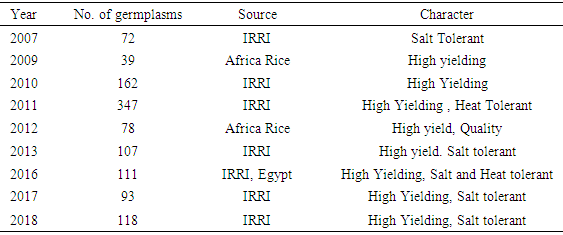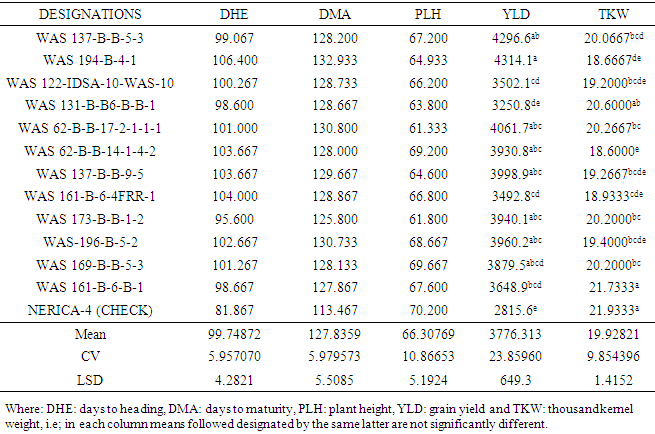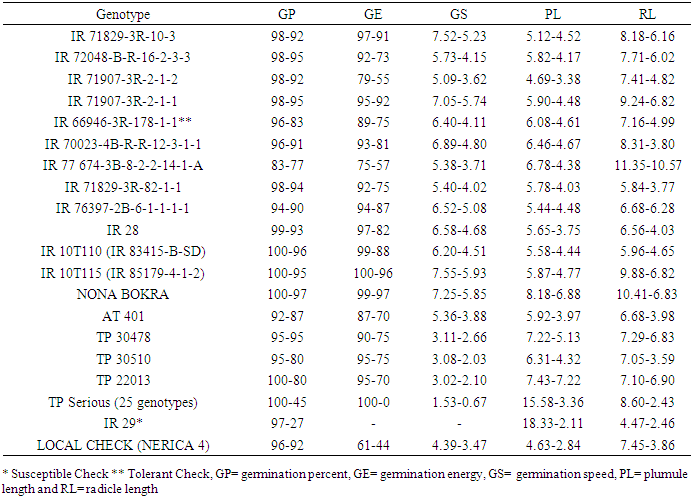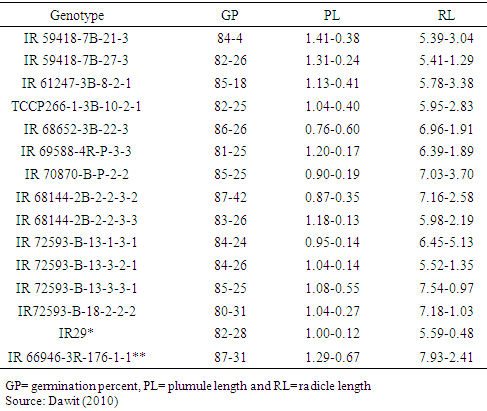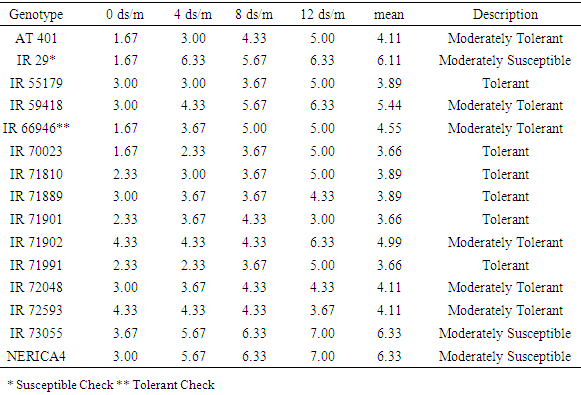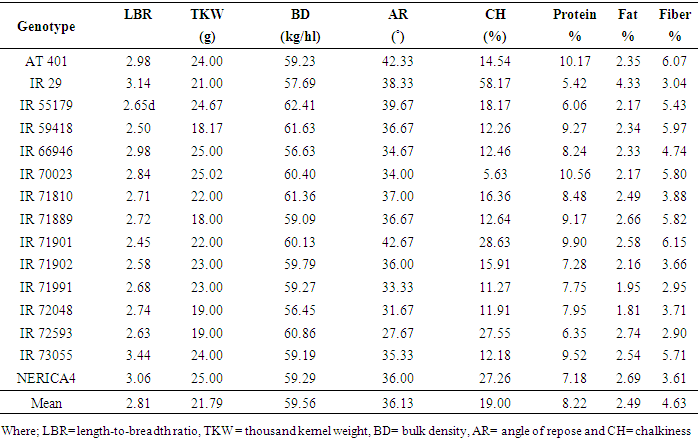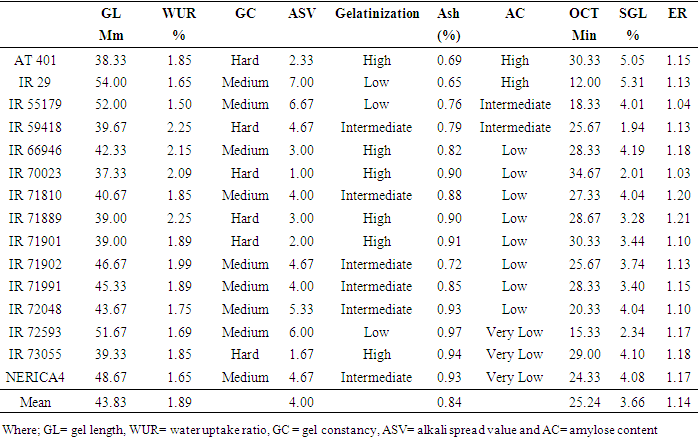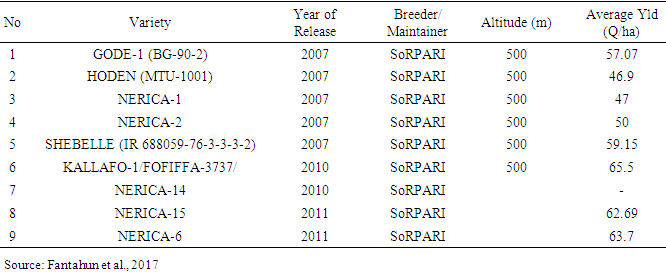-
Paper Information
- Previous Paper
- Paper Submission
-
Journal Information
- About This Journal
- Editorial Board
- Current Issue
- Archive
- Author Guidelines
- Contact Us
International Journal of Agriculture and Forestry
p-ISSN: 2165-882X e-ISSN: 2165-8846
2018; 8(6): 204-212
doi:10.5923/j.ijaf.20180806.02

Rice Improvement for Irrigated Lowland Agro-ecologies of Ethiopia: Achievements, Opportunities, Challenges and Future Directions
Beakal Tadesse Girma1, Desta Gebere Banje2, Mihratu Amanuel Kitil3
1Hawassa National Maize Research Sub-Center, Wendogent Agricultural Research Center, Ethiopian Institute of Agricultural Research, Hawassa, Ethiopia
2Technology Multiplication and Seed Research Directorate, Ethiopian Institute of Agricultural Research, Addis Ababa, Ethiopia
3Werer Agricultural Research Center, Ethiopian Institute of Agricultural Research, Werer, Ethiopia
Correspondence to: Beakal Tadesse Girma, Hawassa National Maize Research Sub-Center, Wendogent Agricultural Research Center, Ethiopian Institute of Agricultural Research, Hawassa, Ethiopia.
| Email: |  |
Copyright © 2018 The Author(s). Published by Scientific & Academic Publishing.
This work is licensed under the Creative Commons Attribution International License (CC BY).
http://creativecommons.org/licenses/by/4.0/

Rice is an important food grain crop contributing one third of nutrition and caloric intake in the world. It has a wide range of adaptation that led to evolution of thousands of varieties having diverse cooking, eating and nutritional characters. In Ethiopia, rice is one of strategic commodity that is expected to promote agricultural production. The country has a potential of 3.7 million ha land for irrigated low land rice production. Irrigated rice research recently started in 2001. Since then research on irrigated rice variety development has been conducted by both Somalia Pastoral and Agro-pastoral Research Institute (SoPARI) and Werer agricultural research center (WARC). Irrigated rice improvement program works on strategies such as broadening the genetic bases, stress screening, improvement for additional merits and parental selection for future improvement. So far, more than 2000 rice germplasms have been introduced and evaluated with the objectives of developing high yielding and salinity tolerant varieties. As the result, nine high yielding irrigated rice varieties have been released following the variety development procedures and up 10 salt tolerant genotypes were identified. In addition, 8 genotypes with different grain quality (physical, nutritional and cooking) were identified and three high yielding genotypes are promoted to variety verification trial. However, the genetic improvement is totally dependent on the introduction of rice germplasms. Therefore, it is advisable to establish national crossing block with modern breeding tools and improvement program for development of irrigated rice genotypes for future high yielding, stress tolerant and nutritionally rich rice varieties. Moreover, physical capacity building of the irrigated rice research program is very crucial.
Keywords: Improvement, Irrigated rice, Genotype
Cite this paper: Beakal Tadesse Girma, Desta Gebere Banje, Mihratu Amanuel Kitil, Rice Improvement for Irrigated Lowland Agro-ecologies of Ethiopia: Achievements, Opportunities, Challenges and Future Directions, International Journal of Agriculture and Forestry, Vol. 8 No. 6, 2018, pp. 204-212. doi: 10.5923/j.ijaf.20180806.02.
Article Outline
1. Introduction
- Rice is one of the most important food grain crop with regard to human nutrition and caloric intake. It is known by its nutritional diversification with wide range of adaptation that led to evolution of thousands of varieties having diverse cooking, eating and nutritional characters [1]. Because of this wide range of diversification, it is a staple food for more than half of the world population providing one fifth of calorie and 15% protein consumption [2, 3]. In Ethiopia, the second populous nation in sub Saharan Africa, rice is becoming the strategic commodity that has received a due emphasis in promotion of agricultural production. It is considered as one of the alternative agricultural technology for farmers for efficient utilization of marginal resources [4]. Ethiopia has considerably vast agro-ecologies suitable for rice production which is unsuitable for production of other food crops [5]. Generally, the country has a potential of 3.7 million ha land for irrigated low land rice production [5]. Despite this, lack of well adaptable variety along with appropriate packages as well as pre- and post-harvest technologies such as row planters, harvesters, seed cleaners and milling machines are the major challenges for expansion of rice production and utilization in the irrigated lowland areas of Ethiopia.Rice research in irrigated areas was started in 1969 and continued until 1972 (progress reports, 1970, 1971 and 1972). Then after, it was discontinued for many years and reinitiated in 2001 by introducing 50 rice genotypes from the rice national research program which was coordinated at that time from Pawe Agricultural Research Center. Since then research on irrigated rice technologies development has been conducted by both Somalia Pastoral and Agro-pastoral Research Institute (SoPARI) at Wabe-Shebelle basin and Werer agricultural research center (WARC) at Awash basin. The variety development works had two parts. The first part included rice varieties adaptation trial and the second one was introduction and evaluation of rice germplasm. The genetic improvement work was totally dependent on the introduction of rice germplasms mainly form International Rice Research Institute (IRRI) and Africa Rice Center. So far, more than 2000 rice germplasms have been introduced and evaluated in different locations of Afar and Somali regions with the objectives of developing high yielding and salinity tolerant varieties. Therefore, nine high yielding irrigated rice varieties have been released following the variety development procedures [6] but no salinity tolerant varieties were released. However, up to 10 salinity tolerant rice genotypes (up to 12dS/m) were identified. Note that the rice crop is very sensitive to salinity beyond 3dS/m. In addition to variety development works, research on rice production practices such as sowing date, irrigation water application intervals, seed rate, fertilizers application rate and time, sowing method and weed management have been conducted and recommended. Using the released and adapted rice varieties and the rice production practices developed by the research centers, the extension departments of Werer and Gode Research Centers along with the development agents conducted rice technologies demonstration works strongly on agro-pastorals’ fields and the results were very impressive. Despite these all research efforts, rice production has not in place in both regions mainly due to lack of rice milling machines.This manuscript, therefore, is briefly discussed on progresses made so far in rice varieties development for lowland irrigated agro-ecologies, opportunities, challenges as well as future research and development directions.
1.1. Irrigated Rice Production Trend
- Nationally the production rice increased from 112,443 Quintals (2005/06) to 1,360,007 Quintals (2016/17) with 7.25% increase in production and 484,181 ha in terms area [7]. The above mentioned progresses were mainly in midland areas of the country. The production in the last two years (2016/17) showed 6.25% increase. Although there is high potential in lowland arid and semiarid areas, it was not yet utilized. The lowland irrigated areas like Afar, Somali, Gambella, Oromia and similar agro-ecologies production data were not documented in CSA but the seed multiplication, research results, existing potential and opportunities shows there should be especial concern to exploit it.
1.2. Research Strategy
- Irrigated rice improvement program focused on releasing of high yielding and salt tolerant varieties through the following methods.1. Broadening the genetic bases of rice through introduction for selection and further breeding works.2. Considering climate and other abiotic factors as opportunities for genotypes screening.3. Evaluation of rice genotypes for their additional merits (nutrition and grain quality).4. Identification of mega environments for irrigated agro ecologies.5. Identify the source parental lines for different desirable traits in the future crossing program.
1.3. Germplasm Introduction
- Since the establishment of rice research more than 2000 germplasm were introduced from International Rice Research Institute (IRRI), Africa Rice and national research institutes form east and South African countries. Most of the genotypes were high yielding genotypes. The remaining were for heat and salinity tolerance. Few of them had merits of grain quality such as nutrition, aroma and taste.
|
1.4. Achievements
1.4.1. Research Work
- Most of the research work deals with introduction and evaluation of high yielding genotypes at different evaluation stage. The other is evaluation of salinity tolerant genotypes. Currently, three national variety trials (NVTs) for high yielding and two national variety trial for salinity are under evaluation. Also for the same traits different genotypes are under evaluation under preliminary and lower evaluation stages. In addition, some activities had been conducted regarding grain quality. Moreover, grain quality analysis is currently started at NVT or Variety verification stage. In the short term plan conducting grain quality analysis at lower evaluation will be possible with the equipment like near infrared (NIR) technology. Some of the research conducted and the achievements made will be discussed in the following sections. 1.4.1.1 Evaluation of High Yielding GenotypesThe study in on evaluation of 13 rice genotypes for four years (2010-13) at two location (Werer and Gewane) indicated the mean performance of all the genotypes were superior to the check (2815 kg/ha). The highest grain yield (4314.1 kg/ha) was obtained from WAS 194-B-4-1 followed by WAS 137-B-B-5-3 (4296.6 kg/ha) and WAS 62-B-B-17-2-1-1-1 (4061.7 kg/ha). These genotypes were proceeded to the next evaluation stage for variety verification. The local check was early type, tall and possessed high 1000 grain weight as compared to all the genotypes evaluated (Table 2).
|
 | Table 3. Mean, Range and Genetic Parameters for different Traits of 64 rice genotypes |
|
|
|
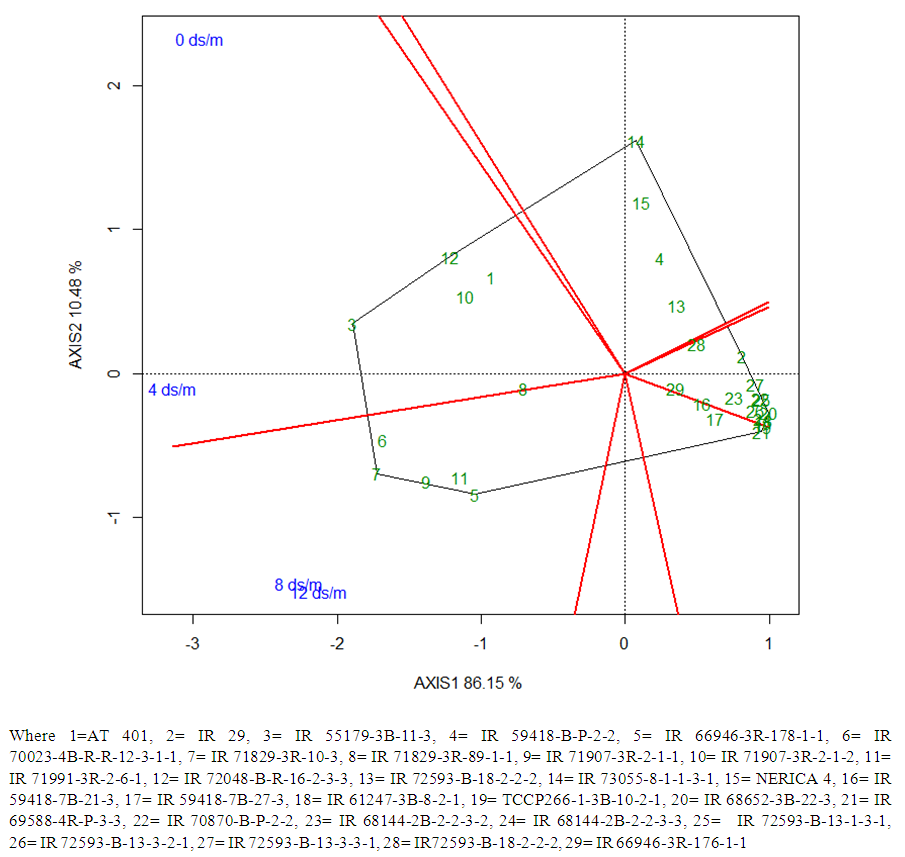 | Figure 1. GGE (Genotype main effect plus Genotype by Environment interaction) Biplot Analysis of Grain Yield |
|
|
1.4.2. Variety Released
- As it was discussed above the variety release totally dependent on introduction. Through introduction and evaluation about 9 varieties had been released by Somali Region Pastoral and Agro pastoral Research Institute (SoRPARI) since 2007 (Table 9). Also in 2015/16 three varieties were presented for verification by Werer Agricultural Research Center (WARC). The varieties were namely WAS 137-B-B-5-3, WAS 194-B-4-1 and WAS 62-B-B-17-2.
|
1.5. Resources
- Currently, irrigated rice research is totally handled by Werer Agricultural research center. At Werer rice improvement program two MSc and Two BSc (one MSc Student) are working. In addition, at Somali and Afar research centers two researchers (MSc) are available for rice research. In terms of location, Werer is the only location currently exploited. But Gewane, Methara, Deho, Gode and Dubti are also the potential areas as a testing locations. But capacitating such areas with irrigation infrastructure is needed. Irrigated rice mostly dependent on field experiments although some facilities are shared with other research programs like lath house and laboratories. In order to grow irrigated rice research more facilities such laboratories (food and nutrition), green house, lath house and cold store should be available.
2. Challenges
- Lack of milling machine for research and production is one of the major problem that limits the production and expansion of rice in irrigated areas. Lack wide adaptable varieties and the expansion of salinity are also challenging the production. Genetic improvement without wide range of germplasm is difficult. So establishing the cold room for preservation of germplasm should be the first priority. Also in the genetic improvement and selection including of varieties with good grain quality at lower evaluation is not possible without equipments like Near Infrared (NIR) Technology. So such kind of equipment are important to consider quality parameters. In addition, shortage of expertise in rice especially in regional centers made the improvement and variety development very slow and inconsistent. Moreover, lack experience in rice breeding (crossing) especially from the national program and shortage of budget made the improvement program totally dependent on introduction. Lack of testing location is the other most important factor that hamper the variety release for irrigated lowland agro-ecologies.
3. Future Direction
- Due you to its is wide range of nutritional use rice is introduced and production expanding in Ethiopia. For increasing its productivity and wide adaptability, irrigated agroecology is important. For securing sustainable variety development, genetic improvement through conventional and molecular tools is necessary. So establishments of permanent crossing block in needed. Further parental selection for hybrid and inbred development will be done. Also development of inbred parents for different abiotic stress and good grain quality will be conducted. Moreover, integration of modern plant breeding tools in different aspects will make the genetic improvement of rice simple and faster. In addition, mechanization is playing a key role for rice production and expansion. Therefore, due attention must be given for changing traditional rice production system in to mechanized system.
 Abstract
Abstract Reference
Reference Full-Text PDF
Full-Text PDF Full-text HTML
Full-text HTML